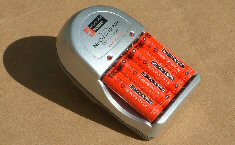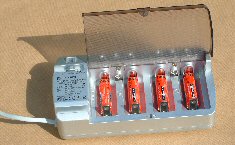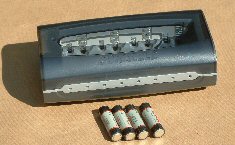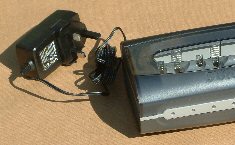|
|||
|
|
|
||
| View Shopping Cart |
| Home |
| Guides Available |
| About the Author |
| FAQs |
| Testimonials |
| Articles |
| Contact Andrew |
| Terms & Conditions |
| Mailing List |
| Links |
 |
 |
Get more articles like
this one absolutely free with every
Gibbs Guides e-magazine. Join
the mailing list!
How to Charge Individual Hydride Batteries
Andrew Gibbs ponders a common question
Many people use individual, rechargeable nickel metal hydride (NiMH) batteries. Individual AA size hydride batteries, or more correctly, cells are often used in 2.4GHz transmitters, and as well as this there are many items of domestic equipment that employ AAA, AA, C and D size batteries, such as cameras and flashlights.
The most common way to charge these batteries is to pop them into a simple charger, taking a guess as to how long to charge them for. Estimating the required charge time isn't a perfect solution as batteries usually end up undercharged or overcharged. Hydride batteries will tolerate some overcharging but this will cause some degradation in their condition to occur. A few such instances will be of little consequence, but if overcharging is a repeated occurrence, as invariably occurs using simple chargers then the cumulative effect will be to shorten battery life. Hydrides aren't especially durable, so avoiding overcharging will help to maximise their already limited life span.
Until recently I've been charging my individual hydride cells using a simple charger. Although I was careful to match the charge time to the charger output using one of the graphs in my guide to hydride batteries, some overcharging was still occurring.
| A compact charger like this one may well cause cells to become warm or even hot, even before overcharging occurs. This heat will significantly shorten the life of cells (click small images to enlarge and get more information). | A simple charger like this one will keep charging cells until they are removed from the charger (click small images to enlarge and get more information). |
Duracell CEF 22 charger
Phil Winks, a Successful Electrics reader kindly
alerted me to the existence of the Duracell CEF 22 charger,
which is a microprocessor controlled unit for 1-8 individual
hydride cells. It is claimed that this charger will not
overcharge hydride cells. This seemed to be an excellent
solution for charging individual hydrides, so I went out
and bought one.
The charger appears to be well made and has slots for up to 8 individual cells, each with its own indicator light. It's meant for Duracell's own cells, but I've tried it out with a variety of cell brands.
Using the charger is very simple. Cells are simply clipped into place and, all being well, charging commences, and is indicated by a steady red light. When the cell is charged, the light changes from red to green and no more charge current flows. If the charger detects a problem, charging stops and this is indicated by a the indicator flashing red. On test, I found that AAA and AA cells are charged at a measured 450mA, and 9V PP3 batteries at 40mA. These are sensible charge rates, and mean that a 700mAh AAA cell is charged from flat in about 2 hours, while a 2,000mAh AA cell will be charged in about 5 hours.
The CEF 22 seems to charge most of my AA and AAA cells as I expected; a normal charge followed by a green light indicating charging is complete. Most cells don't become warm during charging, although a few of them do indicating that overcharging has occurred. This needs investigating but it could be that the cells in question are already in poor condition.
On test I found that the charger consistently refused to charge certain of my older cells, suggesting that these have developed a problem. The problem cells have a normal off-load voltage, so the issue may be that they have an increased internal resistance.
I attempted to charge a set of four unused 2,500mAh AA cells which had been living in their packaging since I bought them about 18 months ago Initially the charger refused to charge three of these, giving me a flashing red indicator as soon as the cells were placed in the charge receptacle. I placed the cells in a simple 250mA charger for about 20min, after which the CEF 22 was happy to charge them. It appears that this short charge altered the cell's internal condition for the better. It's possible that the short charge lowered the cell's internal resistance.
| The Duracell CEF 22 charger. AAA and AA cells are charged at 450mA. 9V PP3 batteries are charged at 40mA. | The charger has a separate power supply unit (PSU). This feature helps to keep the cells cool. |
I've only tried to charge two 9V PP3 batteries; one was defective and was refused a charge. The charger accepted the other, but it became quite warm so I stopped charging manually. With such a small sample it not possible to usefully comment on this function of the charger yet.
As an experiment, I also attempted to charge three different makes of 1.5V non-rechargable battery. The CEF 22 refused to charge any of these for more than a minute which I was pleased about.
As I accumulate more experience with this charger I'll share it here.
Using simple chargers
A few words on using simple chargers may be helpful. These
are the sort that continue to charge a battery for as
long as it's in the charger. When using a simple charger,
I slow charge my hydride cells in multiples and try and
minimize overcharging by timing. Although cells will tolerate
limited overcharging at low charge rates they are less
tolerant of heat. For this reason I avoid using the compact
designs of charger that can feed a significant quantity
of heat into the cells due to the proximity of the power
supply (which gets warm) to the cells.
Managing individual cells
One useful idea is organise cells into sets of two or
four as applicable to your needs. This means that cells
can be kept as a set, so their usage and charging history
stays similar.
Battery capacity
Experience shows that the really high capacity hydride
batteries seem to be more prone to failure than the lower
capacity ones. When buying buying individual AA cells
I prefer those with a maximum capacity of around 2,000mAh.
For a safety critical application such as a transmitter,
I avoid buying cheap, lower quality cells.
Battery life
Hydrides don’t seem to last anywhere near as long
as the nicads they replaced. However, I've found cell
life to be acceptable using the strategies outlined above.
Click here for more about the guide to Hydride batteries
Get more useful information
absolutely free with every
Gibbs Guides e-magazine. Join
the mailing list!



